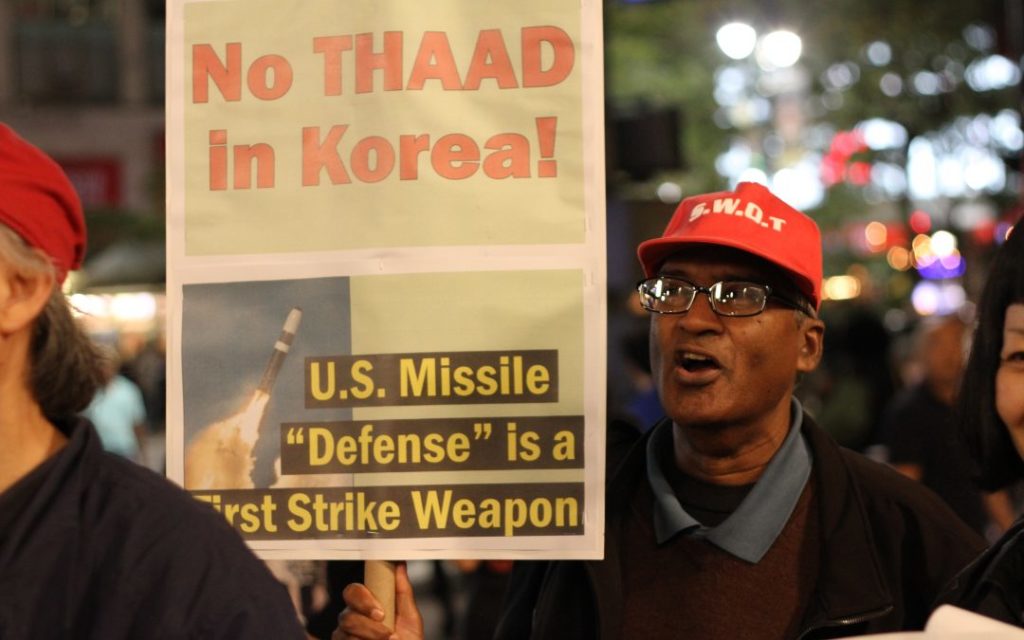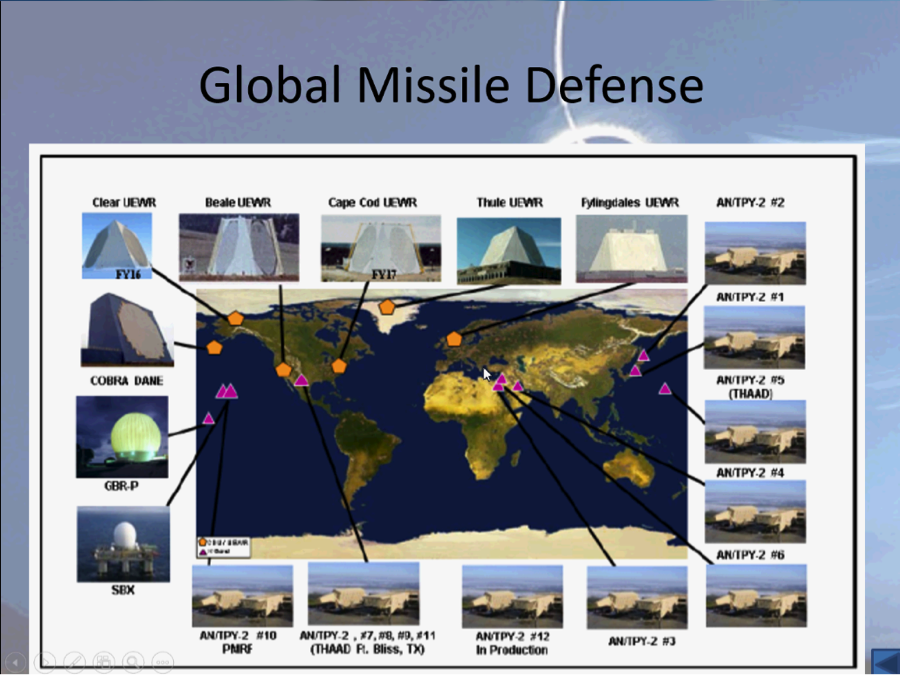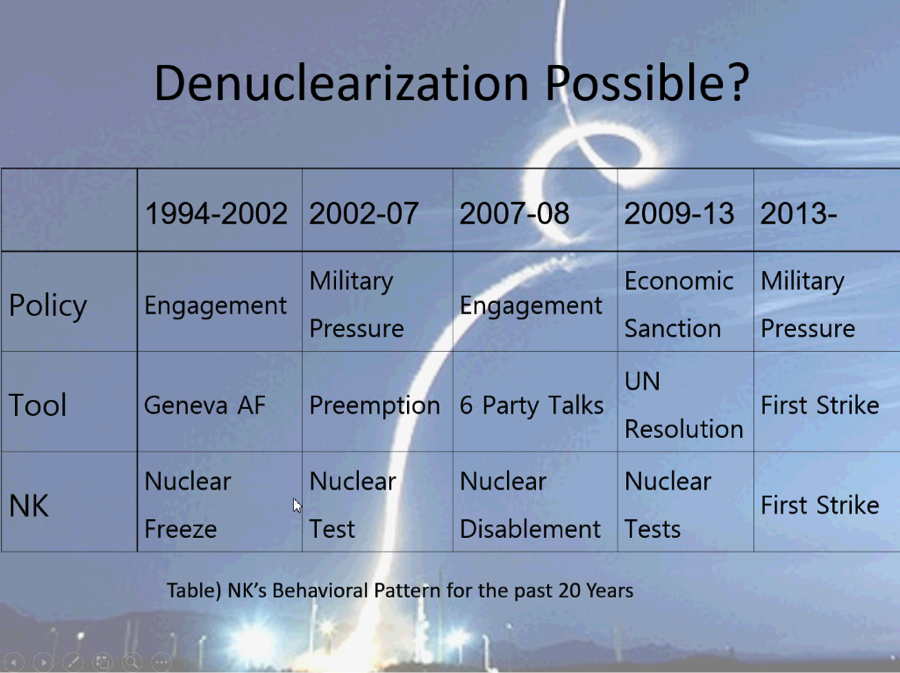How U.S. Missile Defense Destabilizes the World
MILITARISM, 6 Mar 2017
William Griffin | Zoom in Korea – TRANSCEND Media Service
23 Feb 2017 – Contrary to defense industry claims, missile defense does not make the world a safer place but rather destabilizes it, warned Dr. Jae-jung Suh and Ray McGovern during a recent online webinar organized by StopTHAAD.org. StopTHAAD.org is a coalition of organizations building awareness and helping to grow a movement to stop the deployment of U.S. missile defense (MD) systems, such as the Terminal High Altitude Area Defense (THAAD) system, which the Pentagon plans to deploy in South Korea this year.
MD systems are designed to detect, track, intercept and destroy incoming missiles. Initially built to intercept intercontinental ballistic missiles (ICBMs), MD has broadened to include shorter-range non-nuclear tactical and theater missiles. MD allows first nuclear strike capability. During the Cold War, the doctrine of mutually assured destruction (M.A.D.) deterred nuclear powers from actually attacking each other with nuclear weapons. If one side were to attack, the other side would retaliate with a counter-attack, thereby mutually assuring each other’s destruction, and this prevented all parties from initiating conflict. The aim of MD, however, is to rid the enemy’s ability to mount a retaliatory attack and thereby secure first strike capability. This makes nuclear weapons a more “usable” option.
In 1972, the U.S. and Soviet Union signed the Anti-Ballistic Missile (ABM) Treaty. This, according to Ray McGovern, who served as a CIA analyst from 1963 to 1990 and is now an anti-war activist, allowed each country only two ABM sites. Two ABM sites are hardly enough to guarantee nationwide protection. The signing of this treaty ensured that neither country could attack the other without “suffering a crippling blow in retaliation,” said McGovern, who had the privilege of attending the historic signing event.
httpv://www.youtube.com/watch?v=yS5-xKFE4Zk
(Ray McGovern on Missile Defense)
In 2002, former President Bush withdrew the U.S. withdrew from the ABM Treaty, “the main source for strategic stability,”according to McGovern. Since then, the MD industry has been on steroids, and the U.S. has been building and deploying MD systems surrounding Russia. Since 2011, the Pentagon has been implementing what it calls the “European Phased Adaptive Approach” (EPPA). The four phases outlined are as follows:
Phase One: address short and medium range ballistic missile “threats” by deploying sea-based MD systems, Aegis Ballistic MD ships, to the Mediterranean Sea. Phase One also calls for deploying a land-based early warning radar, which Turkey has agreed to host.
Phase Two: expand coverage against short and medium range threats with the fielding of a land-based SM-3 MD interceptor site in Romania, along with a BMD site.
Phase Three: improve coverage against medium and intermediate range missile “threats” with an additional land-based SM-3 interceptor site in Poland.
Phase Four: enhance the ability to counter medium and intermediate range missiles and potential future ICBM “threats” with the deployment of a SM-3 Block IIB interceptor in the Middle East.
Why is the U.S. building MD systems? “Money,” said McGovern, who says the MD industry is basically a corporate welfare system. Missile defense construction was first started by former President Reagan and was coined the Strategic Defense Initiative (SDI), aka “Star Wars.” Later under former President Clinton, the SDI Organization was changed to the Ballistic Missile Defense Organization (BMDO). Then, under former President Bush, it changed again to today’s Missile Defense Agency (MDA). Since its birth, the MD industry has spent over $180 billion of U.S. taxpayer money. According to its website, the Missile Defense Agency requested $7.5 billion for the fiscal Year 2017 to “strengthen and expand the deployment of defense for our Nation, deployed forces, allies, and international partners against increasingly capable ballistic missiles.” This corporate welfare system, says McGovern, only fattens the coffers of the military industrial complex, as warned by former President Eisenhower.
In 2014, when the western intelligence community orchestrated a coup in Crimea to expand NATO eastward, Putin’s response, according to McGovern, was in part prompted by the U.S. deployment of MD in Eastern Europe. When Putin asked the last U.S. ambassador to the Soviet Union, Jack Matlock whether or not deploying MD systems on Russia’s doorstep is a threat to Russian security, Matlock attempted to dispel the argument but responded with something even more disturbing– “It is not to threaten Russia, but to create jobs for American manufacturers and employees.” Putin then asked, “Why would you ‘create jobs’ in an industry that has the potential to put the entire human race in danger?” Russia — and perhaps everyone else except the United States — seems to understand how dangerous and destabilizing MD/ABMs can be.
Speaking to western journalists at an international forum in 2016, Putin accused the U.S. of using the “Iranian threat” to justify its MD systems in Europe. “The Iranian threat does not exist,” he said. Again, Russia interprets U.S. MD as a threat to its national security and an offensive system, which disables its retaliatory capability in the face of an attack. Putin went on to say U.S. citizens “do not feel a sense of the impending danger-this worries me.” McGovern concurred– “There is no rational discussion of these problems within western media apparatus.”
“Trump has huge openings here… And this [MD systems] will be Topic A on Russia’s agenda,” concluded McGovern. “There’s no reason we can’t do another 1972 deal, not just Russia, but extended to the far-east [Asia] as well.”
U.S. THAAD Deployment in South Korea
On July 7, 2016, the U.S. and South Korean governments announced a joint decision to deploy the U.S. Terminal High Altitude Area Defense (THAAD) missile system to South Korea sometime in 2017. Since then, there has been wide disapproval from the South Korean people, who have been waging anti-THAAD protests throughout the country as part of the larger protests against the scandal-ridden President Park Geun-Hye.
THAAD is comprised of five major components: interceptors, launchers, radar, a fire control unit, and support equipment. The two controversial components are the interceptor (hit-to-kill missile) and the radar (AN/TPY-2). The interceptor isn’t effective for short-range missiles from North Korea, according to Dr. Jae-jung Suh, but the radar, if deployed in South Korea, has the potential to expand U.S. surveillance over China. THAAD is built to intercept high altitude intermediate range missiles, not the short range missiles North Korea would use were it to attack the South.
The THAAD system, says Suh, a professor of politics and international affairs at International Christian University in Japan, needs to be understood as part of an arms race on the Korean peninsula as well as the broader global arms race. Suh has been a leading expert on U.S. militarism in the Asia-Pacific for several years and has recently focused his work on the THAAD issue.
The THAAD system would not protect Seoul, where half the South Korean population resides, says Suh. The Pentagon plans to deploy it in the southeastern part of Korea, and it would only be able to protect the southern half of the country, where most U.S. forces are stationed. The THAAD radar, according to Suh, would most likely be used to detect North Korean missiles headed for the United States. It would relay the information to the U.S. THAAD system in Alaska, from where interceptors can be launched to destroy the incoming missile. In other words, the THAAD system doesn’t benefit South Koreans although they will bear the burden of hosting it.
Even former President Obama seems to have known that THAAD is for protecting U.S. assets, not South Korean lives. In an interview with CBS News in 2016, he said, “But what we’re also doing is consulting with the South Koreans, for the first time, about more missile defense capabilities to prevent any possibility that North Korea could reach U.S. facilities or the U.S. population.”
Suh agrees with McGovern that U.S. MD destabilizes the world. The THAAD radar’s ability to conduct surveillance over Chinese soil undermines mutual deterrence between the United States and China. The United States already has two THAAD radars in Japan in addition to its previous-mentioned MD systems in Europe. Tensions in the Asia-Pacific have been rising since the announcement of U.S.’ THAAD deployment in Korea, and China has already retaliated against South Korea with 43 actions.
Suh proposes an immediate freeze and arms control as an alternative. Trump could decide to not deploy the controversial MD system to South Korea and downgrade or stop the annual military training exercises in South Korea, says Suh. If so, he added, North Korea would likely be willing to negotiate, which is the only path to peace.
Tracing the history of North Korea’s responses to U.S. actions since 1994 to the present underscores this point and provides useful instruction on how to move forward, says Suh. As the following chart shows, each time the U.S. was willing to engage in discussion, North Korea responded with freezing its nuclear program and even disabled it for a moment. But every time the U.S. intensified military pressure, North Korea re-ignited its nuclear program.
httpv://www.youtube.com/watch?v=uON7s6e_pmI
(Professor JJ Suh on the THAAD and the global arms race)
__________________________________
William Griffin is a member of Veterans for Peace and a Steering Committee member of the Task Force to Stop THAAD in Korea and Militarism in Asia and the Pacific.
Go to Original – zoominkorea.org
DISCLAIMER: The statements, views and opinions expressed in pieces republished here are solely those of the authors and do not necessarily represent those of TMS. In accordance with title 17 U.S.C. section 107, this material is distributed without profit to those who have expressed a prior interest in receiving the included information for research and educational purposes. TMS has no affiliation whatsoever with the originator of this article nor is TMS endorsed or sponsored by the originator. “GO TO ORIGINAL” links are provided as a convenience to our readers and allow for verification of authenticity. However, as originating pages are often updated by their originating host sites, the versions posted may not match the versions our readers view when clicking the “GO TO ORIGINAL” links. This site contains copyrighted material the use of which has not always been specifically authorized by the copyright owner. We are making such material available in our efforts to advance understanding of environmental, political, human rights, economic, democracy, scientific, and social justice issues, etc. We believe this constitutes a ‘fair use’ of any such copyrighted material as provided for in section 107 of the US Copyright Law. In accordance with Title 17 U.S.C. Section 107, the material on this site is distributed without profit to those who have expressed a prior interest in receiving the included information for research and educational purposes. For more information go to: http://www.law.cornell.edu/uscode/17/107.shtml. If you wish to use copyrighted material from this site for purposes of your own that go beyond ‘fair use’, you must obtain permission from the copyright owner.


